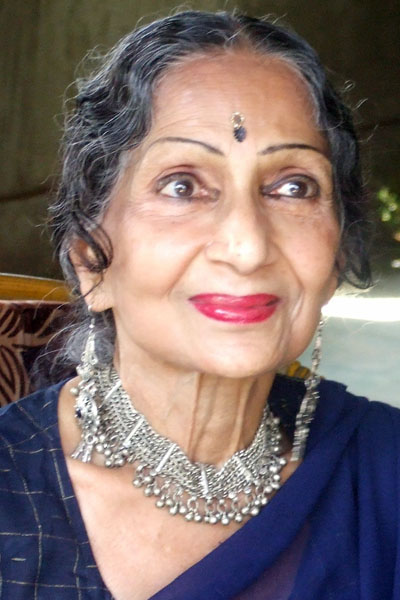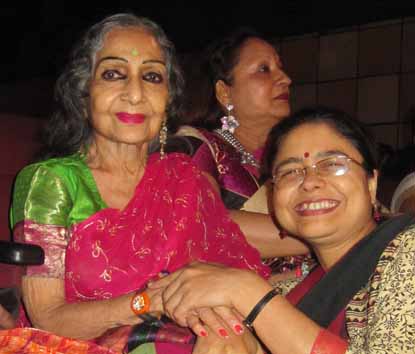
Carrying forward the Legacy : Ritha Devi
On the 13th of April, 2013, I was at the Nehru Memorial Hall, Pune as my daughter Anubhuti was to perform Odissi with her troupe from Bhanja Kala Kendra, Rourkela, Odisha. After the performance we met the chief guest, a veteran Indian classical danseuse, the beautiful and petite octogenarian Ritha Devi.
I struck up a conversation with Ritha Devi, and my happiness knew no bounds when she told me that she is the granddaughter of Sahityarathi Lakshminath Bezbaroa. Bezbaroa had three daughters, namely, Aruna, Ratna and Deepika; Ritha Devi is Aruna’s daughter.
In addition to the fact that she is the granddaughter of Sahityarathi Lakshminath Bezbaroa, Ritha Devi is also the great-grand-niece of Nobel laureate Rabindranath Tagore. She has studied seven forms of Indian classical dance from the most orthodox Gurus for each style, namely, Manipuri, Bharatnatyam, Kathakali, Mohiniattam, Sattriya Nritya, Kuchipudi and Odissi, each in its entirety and traditional purity. But she is most renowned, and acknowledged all over India and abroad, as a pioneer in the revival and international projection of the Mahari (Devadasi of the Shri Jagannatha temple at Puri, Orissa) tradition of the Odissi style, which she has studied, from 1963 onwards, from Adiguru Shri Pankaj Charan Das, direct descendant of the Maharis and a trail-blazer in the renaissance of this tradition.
Ritha Devi was also the first woman to have been taught the sacred Sattriya Nritya of Assam, and the first dancer to take it out of Assam and out of India. She has also studied some other traditional dances of Assam, like the Deodhani and the Deonati, which were almost on the verge of extinction, and was again the first dancer to showcase them in the international platform.

When I told her that I am from Assam, her eyes lit up with undisguised enthusiasm. I had the good fortune to share a few precious moments with this great lady. I revealed my desire to pay her a visit the next day, and she gracefully invited me over. So the next day, I found myself at her artistically done tiny apartment at Leela Garden, Kalyaninagar, Pune.
I found myself wondering about the way she spelt her name (“Ritha”), which had a Dravidian feel to it. When I inquired, she replied, “During one of my foreign tours, the organizers suggested that I should change my name as it sounded European and foreign audience was more attracted towards Indian dancers. I refused to change it altogether but modified the spelling that way to satisfy them.”
“Please share some of your childhood memories of your grandfather.” I asked her.
“I was born on the 6th of December, 1924. I grew up in Baroda with my parents Aruna and Satyabrata Mukherjee; but during our vacations we frequently used to visit my grandparents at Sambalpur, Odisha. My grandfather Lakshminath Bezbaroa married the daughter of Hemndranath Tagore, elder brother of Kabiguru Rabindra Nath Tagore.”
She continued after a pause, he eyes misting over, “My grandparents were one soul in two bodies. Once my mother wrote about my grandmother Pragya Sundari Devi – “She was the wind in his flute, the refrain of his songs, the confidence-giver of his ambitions.” I fondly remember going on long walks along the banks of Mahanadi holding my grandfather’s finger, listening to his numerous experiences. He seemed to love me more than my brother as I showed a lot of interest in literature. My mother was like a secretary to him.”
“When did you take up dance seriously as a vocation?”
“I started my formal dance lessons in Shillong after my graduation from Bombay University. And I had, not one but several gurus as I was fascinated by seven forms of Indian classical dance. Against strong objection from my father, I started learning Manipuri under Guru Howbam Athumba Singh.
After a few years my parents took me to Calcutta to look for a suitable groom for me. Finally in 1950, I married Indra Chatterjee who promised to support my career in dance. But my illusion lasted only as long as our honeymoon in Sri Lanka as I discovered his severe dislike for dance after he witnessed Kandyan, a classical dance form of that country. I was taken aback by his rage and after coming back to Bombay, for some months I played the role of a devoted housewife. But my spirit could not be suppressed for long. During that period my guru Howbam Athumba Singh requested me to help him open a dance institute in Bombay and I readily agreed.
In 1953 my husband got transferred to Madras. Defying my husband I started learning Bharat Natyam under Natyakalanidhi Pandanallur Chokkalingam Pillai. To help my dance, I also started learning Tamil. My knowledge of Sanskrit literature gained during my college days helped me immensely in my dance. Within a period of seven months I did my Arangetram. I was a contemporary of Yamini Krishnamurthy and Indrani Rehman.”

Ritha Devi took numerous performance-tours all over the world including tours in Great Britain, France, Germany, Austria, Switzerland and Denmark, the U.S.A. and Russia. On her fourth tour of the U.S., she was invited by the New York University to teach Indian dance, and the assignment persuaded her to leave Bombay, her hometown, and settle down in New York, where she stayed for ten years. She also gave performances, lecture-demonstrations and conducted workshops all over the States. During her stay there, she was awarded three choreography fellowships, one, in 1979, from the Creative Artists’ Public Service Program, based in New York, and two (in 1982 and 1984) from the greatly-reputed Washington-based National Endowment for the Arts, all for her contribution towards building a bridge of friendship between the East and the West, with her choreography of themes from the Bible, and from Jewish and Greek mythology, in Indian techniques.
She continued, “In 1958. It was with the recommendation of Pandit Ravi Shankar that I made a tour to England, Germany and France. My item ‘Putana Moksha’ became quite famous. During this tour my husband sent me the divorce papers. But we tried reconciliation.”
“I went to America four times for performance. It was during the fourth visit in 1971 that I was offered a position in the dance department in the New York University by the chairman to teach Indian dance. From 1972 my stint continued till 1982. During my stay in America, I used to visit my country every winter, learnt new items of Kuchipudi from my guru and gave performances in places like Ahmedabad, Bombay, Delhi and Bhubaneswar. After that I started giving private dance lessons to Indian students in places like Philadelphia, Albany and New Jersey till 2003, the year of the attack on the World Trade centre. After this disaster, along with many other Indians I was forced to leave America forever.”
“Could you please let us know about your family?”
“Our only son Rahul, who is a musician and an artist, was born in 1959. After his birth, I started learning another southern form Kathakali under Asten Karunakaran Panikkar. Only with one singer, drummer and a violinist I went for my second foreign tour in 1962. After coming back I started learning yet another dance form, Odissi, as my thirst for dance was difficult to be quenched. I went all the way from Bombay to Puri in 1964 to learn it in its own land under Guru Pankaj Charan Das. That year I also went for my third foreign tour.”
She stated that her strained marriage finally came to an end in 1968.
“It must have been a very difficult period for you!”
“It was miserable for a mother of a young child to carry out a vocation like dance without the support of a husband. But my passion for dance gave me strength to cross all the hurdles in life. Moreover it became my only source of living by that time as I was given a paltry alimony by my husband. In 1969, I started learning Kuchipudi from Dr.Vempati Chinna Satyam in Bombay. He charged a huge fee for teaching dance, but seeing my earnestness for this art, he was ready to teach me without taking any remuneration. I did my Rangapravesh (Arangetram ) in Chennai.”
She further revealed that though she was keen to settle down in Mumbai, she had to set up base in Pune as Mumbai was too expensive. When I asked about her future plans, she said, “My last public performance was in Swami Haridas Sammelan in 2009. But my practice, private performances and dance tuitions still continue. Occasionally I also write articles on dance in journals like AttenDance and Nartanam. Till now I have managed to look after myself as it is below my dignity to depend on others. My passion for dance and my self-respect have kept me going till this ripe age of eighty eight.”
She stays with her son Rahul, who is a computer engineer by profession but is deeply devoted to music and arts.
Acknowledging the fact that in the recent years, she has not been in touch with Assamese literature and culture, Ritha Devi reminisced about her tour of Assam which she took in 1965. “My last visit to Assam was decades ago, in 1965. I toured Guwahati, Jorhat, Tezpur and Tinsukia along with musicians by car. It was the time of India- Pakistan war; during our visit there was air –raids and black-outs and I had to perform in kerosene lamp. Jatin Goswami and Rosheswr Saikia liked my dance so much that they offered to teach me xattriya and suttradhari dance. I was so charmed by this dance form that I not only learnt from them but also performed in Bombay in 1966.”
Ritha Devi has carried the legacy of her prolific grandfather forward. It may be mentioned here that Ritha Devi’s “magnum opus” is her revival of the “Panchakanya” solo dance-dramas from the traditional Mahari repertoire, revolving around the tragic lives of five legendary heroines, Ahalya, Draupadi, Tara, Kunti and Mandodari, and presentation of all five of them, in a marathon four-hour performance, in Bombay, in August 1971. She has been, so far, the only dancer to have danced all five of them all together, and the first to have danced them outside the temple, where even they had not been danced for over a century. She has been acclaimed, by connoisseurs, as well as by the general public, as the greatest exponent of these five dance-dramas. This remains her greatest claim to fame, and to a place in the annals of Odissi dance-history.
Finally, it was time to end this wonderful rendezvous with the granddaughter of the most beloved literary figure of Assam. As a parting query, I asked her, “This year we are celebrating the 150th birth anniversary of Sahityarathi Lakshminath Bezbaroa. Given a chance, would you like to visit Assam for the occasion?”
Hearing this, the grand granddaughter of Assam replied promptly, “I would love to; but given the circumstances I will have to be sponsored by somebody.”
With a promise to convey her message to the people of Assam, I thanked for the wonderful couple of hours wherein I shared invaluable moments with the descendent of the Sahityarathi. The lines of a poem by Lakshminath Bezbaroa echoed in my mind –
“হেৰা অসমীয়া, নোহোৱা দুখীয়া
কিহৰ দুখীয়া হবা?
নিজ নাপাহৰি বিভুক সুঁৱৰি
লাগাচোন সুফল পাবা।
‘বুৰঞ্জীৰ হব পুনৰ অভিনয়’
জ্ঞান বৃদ্ধসৱে গায়,
লক্ষ্য স্থিৰ ৰাখা, আগবাঢ়ি যোৱা,
মানুহমুৱা হোৱা ভাই।
বাজক দবা, বাজক শঙ্খ
বাজক মৃদং খোল,
অসম আকৌ উন্নতি-পথত
‘জয় আই অসম’ বোল।“
Ritha Devi, Dies at the age of 92 in 2017.
A very ardent follower of SPIC MACAY and a sitar student of Akhtar Khan, Rupalim Patgiri currently residing in Rourkela, Odisha; her email id: rupalim.patgiri@gmail.com